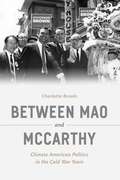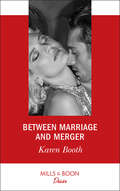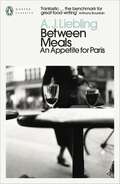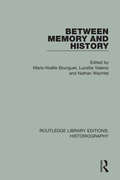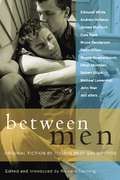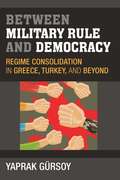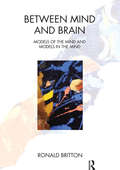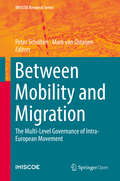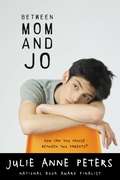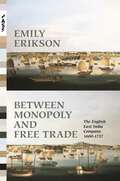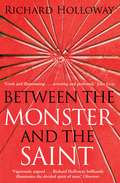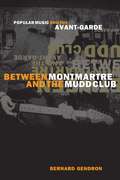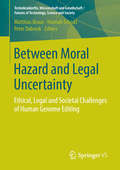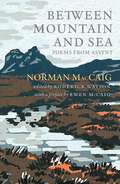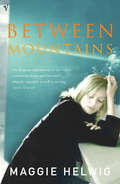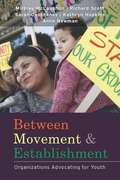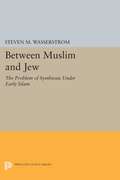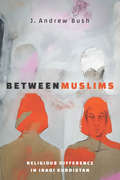- Table View
- List View
Between Mao and McCarthy: Chinese American Politics in the Cold War Years
by Charlotte BrooksDuring the Cold War, Chinese Americans struggled to gain political influence in the United States. Considered potentially sympathetic to communism, their communities attracted substantial public and government scrutiny, particularly in San Francisco and New York. Between Mao and McCarthy looks at the divergent ways that Chinese Americans in these two cities balanced domestic and international pressures during the tense Cold War era. On both coasts, Chinese Americans sought to gain political power and defend their civil rights, yet only the San Franciscans succeeded. Forging multiracial coalitions and encouraging voting and moderate activism, they avoided the deep divisions and factionalism that consumed their counterparts in New York. Drawing on extensive research in both Chinese- and English-language sources, Charlotte Brooks uncovers the complex, diverse, and surprisingly vibrant politics of an ethnic group trying to find its voice and flex its political muscle in Cold War America.
Between Mao and McCarthy: Chinese American Politics in the Cold War Years
by Charlotte BrooksDuring the Cold War, Chinese Americans struggled to gain political influence in the United States. Considered potentially sympathetic to communism, their communities attracted substantial public and government scrutiny, particularly in San Francisco and New York. Between Mao and McCarthy looks at the divergent ways that Chinese Americans in these two cities balanced domestic and international pressures during the tense Cold War era. On both coasts, Chinese Americans sought to gain political power and defend their civil rights, yet only the San Franciscans succeeded. Forging multiracial coalitions and encouraging voting and moderate activism, they avoided the deep divisions and factionalism that consumed their counterparts in New York. Drawing on extensive research in both Chinese- and English-language sources, Charlotte Brooks uncovers the complex, diverse, and surprisingly vibrant politics of an ethnic group trying to find its voice and flex its political muscle in Cold War America.
Between Mao and McCarthy: Chinese American Politics in the Cold War Years
by Charlotte BrooksDuring the Cold War, Chinese Americans struggled to gain political influence in the United States. Considered potentially sympathetic to communism, their communities attracted substantial public and government scrutiny, particularly in San Francisco and New York. Between Mao and McCarthy looks at the divergent ways that Chinese Americans in these two cities balanced domestic and international pressures during the tense Cold War era. On both coasts, Chinese Americans sought to gain political power and defend their civil rights, yet only the San Franciscans succeeded. Forging multiracial coalitions and encouraging voting and moderate activism, they avoided the deep divisions and factionalism that consumed their counterparts in New York. Drawing on extensive research in both Chinese- and English-language sources, Charlotte Brooks uncovers the complex, diverse, and surprisingly vibrant politics of an ethnic group trying to find its voice and flex its political muscle in Cold War America.
Between Mao and McCarthy: Chinese American Politics in the Cold War Years
by Charlotte BrooksDuring the Cold War, Chinese Americans struggled to gain political influence in the United States. Considered potentially sympathetic to communism, their communities attracted substantial public and government scrutiny, particularly in San Francisco and New York. Between Mao and McCarthy looks at the divergent ways that Chinese Americans in these two cities balanced domestic and international pressures during the tense Cold War era. On both coasts, Chinese Americans sought to gain political power and defend their civil rights, yet only the San Franciscans succeeded. Forging multiracial coalitions and encouraging voting and moderate activism, they avoided the deep divisions and factionalism that consumed their counterparts in New York. Drawing on extensive research in both Chinese- and English-language sources, Charlotte Brooks uncovers the complex, diverse, and surprisingly vibrant politics of an ethnic group trying to find its voice and flex its political muscle in Cold War America.
Between Marriage And Merger: Rich Rancher's Redemption (texas Cattleman's Club: The Imposter, Book 2) / Between Marriage And Merger (the Locke Legacy, Book 3) (The Locke Legacy #3)
by Karen BoothFrom boardroom to bedroom… and back?
Between Meals: An Appetite for Paris
by A. J. Liebling'Fantastic. The benchmark for great food writing' Anthony Bourdain'The primary requisite for writing well about food is a good appetite'Between Meals is the gourmand and journalist A.J. Liebling's delectable account of his time spent eating and drinking in 1920s Paris, under the tutelage of his friend Yves Mirande, 'one of the last of the great around-the-clock gastronomes of France'. With gluttonous joie de vivre, he fondly recalls everything from glorious dining ('A leg of lamb larded with anchovies, artichokes on a pedestal of foie gras, and four or five kinds of cheese') to bad rosé ('a pinkish cross between No-Cal and vinegar'), and an ill-fated sojourn at a Swiss slimming-clinic. Witty, tart and full of gusto, this is a love song to food, wine and Paris.'Liebling transfers excitement, warmth, wit and information ... as hearty and explicit as good Calvados' The New York Times Book ReviewWith an introduction by James Salter
Between Memory and History (Routledge Library Editions: Historiography #6)
by Marie-Noëlle Bourguet Lucette Valensi Nathan WachtelThe recent wave of interest in oral history and return to the active subject as a topic in historical practice raises a number of questions about the status and function of scholarly history in our societies. This articles in this volume, originally pubished in 1990, and which originally appeared in History and Anthropology, Volume 2, Part 2, discuss what contributions, meanings and consequences emerge from scholarly history turning to living memory, and what the relationships are between history and memory.
Between Memory and History (Routledge Library Editions: Historiography)
by Marie-Noëlle Bourguet Lucette Valensi Nathan WachtelThe recent wave of interest in oral history and return to the active subject as a topic in historical practice raises a number of questions about the status and function of scholarly history in our societies. This articles in this volume, originally pubished in 1990, and which originally appeared in History and Anthropology, Volume 2, Part 2, discuss what contributions, meanings and consequences emerge from scholarly history turning to living memory, and what the relationships are between history and memory.
Between Men: Best New Gay Fiction (Between Men, Between Women Ser.)
by Richard CanningLambda Literary Award-winning editor Richard Canning brings together all new work by Edmund White, Dale Peck, James McCourt, Andrew Holleran, and others.
Between Military Rule and Democracy: Regime Consolidation in Greece, Turkey, and Beyond
by Yaprak GürsoyWhy do the armed forces sometimes intervene in politics via short-lived coups d’état, at other times establish or support authoritarian regimes, or in some cases come under the democratic control of civilians? To find answers, Yaprak Gürsoy examines four episodes of authoritarianism, six periods of democracy, and ten short-lived coups in Greece and Turkey, and then applies her resultant theory to four more recent military interventions in Thailand and Egypt. Based on more than 150 interviews with Greek and Turkish elites, Gürsoy offers a detailed analysis of both countries from the interwar period to recent regime crises. She argues that officers, politicians, and businesspeople prefer democracy, authoritarianism, or short-lived coups depending on the degree of threat they perceive to their interests from each other and the lower classes. The power of elites relative to the opposition, determined in part by the coalitions they establish with each other, affects the success of military interventions and the consolidation of regimes. With historical and theoretical depth, Between Military Rule and Democracy will interest students of regime change and civil-military relations in Greece, Turkey, Thailand, and Egypt, as well as in countries facing similar challenges to democratization.
Between Mind and Brain: Models of the Mind and Models in the Mind
by Ronald BrittonThis book begins with an exploration of the relationship between mind and brain. It then examines various psychoanalytic models of the mind and moves to the task of the analyst to discover the unconscious models that shape his or her patients' picture of him/herself and others. The familiar models are mainly drawn from psychoanalytic practice but are supplemented from myths, religion, and literature. Developments in adjacent scientific fields such as quantum biology and new ideas about evolution are discussed that suggest cellular genetic modification can take place as a consequence of interaction with the outside world. This gives hope perhaps to the idea that not only the mind can learn from experience but also the brain.
Between Mind and Brain: Models of the Mind and Models in the Mind
by Ronald BrittonThis book begins with an exploration of the relationship between mind and brain. It then examines various psychoanalytic models of the mind and moves to the task of the analyst to discover the unconscious models that shape his or her patients' picture of him/herself and others. The familiar models are mainly drawn from psychoanalytic practice but are supplemented from myths, religion, and literature. Developments in adjacent scientific fields such as quantum biology and new ideas about evolution are discussed that suggest cellular genetic modification can take place as a consequence of interaction with the outside world. This gives hope perhaps to the idea that not only the mind can learn from experience but also the brain.
Between Mobility and Migration: The Multi-Level Governance of Intra-European Movement (IMISCOE Research Series)
by Peter Scholten Mark Van OstaijenThis open access book offers a critical perspective on intra-European mobility and migration by using new empirical data and theoretical discussions. It develops a theoretical and empirical analysis of the consequences of intra-European movement for sending and receiving urban regions in The Netherlands, Sweden, Austria, Turkey, Poland and Czech Republic. The book conceptualizes Central and Eastern European (CEE) migration by distinguishing between different types of CEE migrants and consequences. This involves a mapping of migration corridors within Europe, a unique empirical analysis of consequences for urban regions, and an analysis of governance responses. Next to the European and country perspectives on this phenomenon, the book focuses on the local perspective of urban regions where most mobile citizens settle (either permanently or temporarily). This way the book puts the analysis of intra-European movement in the perspective of broader theoretical debates in migration studies and beyond.
Between Mom and Jo
by Julie Anne PetersNick has a three-legged dog named Lucky, some pet fish, and two moms who think he's the greatest kid ever. And he happens to think he has the greatest Moms ever, but everything changes when his birth mom and her wife, Jo, start to have marital problems. Suddenly, Nick is in the middle, and instead of having two Moms to turn to for advice, he has no one. Nick's emotional struggle to redefine his relationships with his parents will remind readers that a family's love can survive even the most difficult times.
Between Monopoly and Free Trade: The English East India Company, 1600–1757
by Emily EriksonThe English East India Company was one of the most powerful and enduring organizations in history. Between Monopoly and Free Trade locates the source of that success in the innovative policy by which the Company's Court of Directors granted employees the right to pursue their own commercial interests while in the firm’s employ. Exploring trade network dynamics, decision-making processes, and ports and organizational context, Emily Erikson demonstrates why the English East India Company was a dominant force in the expansion of trade between Europe and Asia, and she sheds light on the related problems of why England experienced rapid economic development and how the relationship between Europe and Asia shifted in the eighteenth and nineteenth centuries.Though the Company held a monopoly on English overseas trade to Asia, the Court of Directors extended the right to trade in Asia to their employees, creating an unusual situation in which employees worked both for themselves and for the Company as overseas merchants. Building on the organizational infrastructure of the Company and the sophisticated commercial institutions of the markets of the East, employees constructed a cohesive internal network of peer communications that directed English trading ships during their voyages. This network integrated Company operations, encouraged innovation, and increased the Company’s flexibility, adaptability, and responsiveness to local circumstance.Between Monopoly and Free Trade highlights the dynamic potential of social networks in the early modern era.
Between Monopoly and Free Trade: The English East India Company, 1600–1757 (PDF)
by Emily EriksonThe English East India Company was one of the most powerful and enduring organizations in history. Between Monopoly and Free Trade locates the source of that success in the innovative policy by which the Company's Court of Directors granted employees the right to pursue their own commercial interests while in the firm’s employ. Exploring trade network dynamics, decision-making processes, and ports and organizational context, Emily Erikson demonstrates why the English East India Company was a dominant force in the expansion of trade between Europe and Asia, and she sheds light on the related problems of why England experienced rapid economic development and how the relationship between Europe and Asia shifted in the eighteenth and nineteenth centuries.Though the Company held a monopoly on English overseas trade to Asia, the Court of Directors extended the right to trade in Asia to their employees, creating an unusual situation in which employees worked both for themselves and for the Company as overseas merchants. Building on the organizational infrastructure of the Company and the sophisticated commercial institutions of the markets of the East, employees constructed a cohesive internal network of peer communications that directed English trading ships during their voyages. This network integrated Company operations, encouraged innovation, and increased the Company’s flexibility, adaptability, and responsiveness to local circumstance.Between Monopoly and Free Trade highlights the dynamic potential of social networks in the early modern era.
Between The Monster And The Saint: Reflections on the Human Condition
by Richard HollowayBeing human isn’t easy. We might think that consciousness and free will give us control over our lives but our minds are unpredictable places. We are susceptible to forces we don’t understand. We are capable of inflicting immense cruelty on one another and yet we also have the capacity to be tender, to empathise, to feel. In his thought-provoking new book Richard Holloway holds a mirror up to the human condition. By drawing on a colourful and eclectic selection of writings from history, philosophy, science, poetry, theology and literature, Holloway shows us how we can stand up to the seductive power of the monster and draw closer to the fierce challenge of the saint.
Between Montmartre and the Mudd Club: Popular Music and the Avant-Garde
by Bernard GendronDuring the late nineteenth and early twentieth century, popular music was considered nothing but vulgar entertainment. Today, jazz and rock music are seen as forms of art, and their practitioners are regularly accorded a status on par with the cultural and political elite. To take just one recent example, Bono, lead singer and lyricist of the rock band U2, got equal and sometimes higher billing than Pope John Paul II on their shared efforts in the Jubilee 2000 debt-relief project. When and how did popular music earn so much cultural capital? To find out, Bernard Gendron investigates five key historical moments when popular music and avant-garde art transgressed the rigid boundaries separating high and low culture to form friendly alliances. He begins at the end of the nineteenth century in Paris's Montmartre district, where cabarets showcased popular music alongside poetry readings in spaces decorated with modernist art works. Two decades later, Parisian poets and musicians "slumming" in jazz clubs assimilated jazz's aesthetics in their performances and compositions. In the bebop revolution in mid-1940s America, jazz returned the compliment by absorbing modernist devices and postures, in effect transforming itself into an avant-garde art form. Mid-1960s rock music, under the leadership of the Beatles, went from being reviled as vulgar music to being acclaimed as a cutting-edge art form. Finally, Gendron takes us to the Mudd Club in the late 1970s, where New York punk and new wave rockers were setting the aesthetic agenda for a new generation of artists. Between Montmartre and the Mudd Club should be on the shelves of anyone interested in the intersections between high and low culture, art and music, or history and aesthetics.
Between Montmartre and the Mudd Club: Popular Music and the Avant-Garde
by Bernard GendronDuring the late nineteenth and early twentieth century, popular music was considered nothing but vulgar entertainment. Today, jazz and rock music are seen as forms of art, and their practitioners are regularly accorded a status on par with the cultural and political elite. To take just one recent example, Bono, lead singer and lyricist of the rock band U2, got equal and sometimes higher billing than Pope John Paul II on their shared efforts in the Jubilee 2000 debt-relief project. When and how did popular music earn so much cultural capital? To find out, Bernard Gendron investigates five key historical moments when popular music and avant-garde art transgressed the rigid boundaries separating high and low culture to form friendly alliances. He begins at the end of the nineteenth century in Paris's Montmartre district, where cabarets showcased popular music alongside poetry readings in spaces decorated with modernist art works. Two decades later, Parisian poets and musicians "slumming" in jazz clubs assimilated jazz's aesthetics in their performances and compositions. In the bebop revolution in mid-1940s America, jazz returned the compliment by absorbing modernist devices and postures, in effect transforming itself into an avant-garde art form. Mid-1960s rock music, under the leadership of the Beatles, went from being reviled as vulgar music to being acclaimed as a cutting-edge art form. Finally, Gendron takes us to the Mudd Club in the late 1970s, where New York punk and new wave rockers were setting the aesthetic agenda for a new generation of artists. Between Montmartre and the Mudd Club should be on the shelves of anyone interested in the intersections between high and low culture, art and music, or history and aesthetics.
Between Moral Hazard and Legal Uncertainty: Ethical, Legal and Societal Challenges of Human Genome Editing (Technikzukünfte, Wissenschaft und Gesellschaft / Futures of Technology, Science and Society)
by Matthias Braun Hannah Schickl Peter DabrockGenome Editing Techniques are seen to be at the frontier of current research in the field of emerging biotechnologies. The latest revolutionary development, the so-called CRISPR technology, represents a paradigmatic example of the ambiguity of such techniques and has resulted in an international interdisciplinary debate on whether or not it is necessary to ban the application of this technique by means of a moratorium on its use for human germline modifications, particularly in human embryos in the reproduction process. However, given that other germline engineering techniques like mitochondrial (mt) DNA transfer techniques are already permitted and applied, the question arises what lies at the root of the apparent social unease about the modification of the human germline by Genome Editing Techniques like CRISPR. Against this background, the book seeks to make a substantial contribution to the current debate about a responsible and participatory framework for research on emerging biotechnologies by analysing underlying perceptions, attitudes, arguments and the reasoning on Genome Editing Techniques.
Between Mountain and Sea: Poems from Assynt
by Norman MacCaig'Two Men at Once' is one of Norman MacCaig best known poems. He was indeed two men at once: Edinburgh, the city where he was born and lived as a teacher and poet, was his home, but no other place shaped his poetry more than Assynt in Sutherland. It is here that he would spend many a summer on family holidays, walking the hills and fishing the lochs. MacCaig’s fresh eye saw remarkable newness even in the everyday and each poem is a tiny revelation, a new look at an old friend. This collection celebrates, renews, and rediscovers Norman MacCaig’s Assynt.
Between Mountains
by Maggie HelwigMaggie Helwig's stunning British debut is an extraordinary war novel, a poignant and gripping story about the ripples that carry on long after the fighting is over, and about two people kept apart by history, ethics and human frailty. Daniel is a war correspondent in Bosnia, a loner and a truthteller, up to a point, careless with everything except his sources. Lili is an interpreter, based in Paris, careful and meticulous. But when she finds herself working for the war crimes tribunal in The Hague, fails to declare her fragile relationship with Daniel.Between Mountains is a compelling novel of immediacy and power, about love and language, truth and lies, war crimes and the weight of history - with a vividly evoked and frighteningly real supporting cast of war criminals, lawyers, refugees and journalists.
Between Movement and Establishment: Organizations Advocating for Youth
by W. Richard Scott Anne Newman Milbrey W. McLaughlin Sarah N. Deschenes Kathryn C. HopkinsThis pathbreaking book examines the strategies, successes, and challenges of youth advocacy organizations, highlighting the importance of local contexts for these efforts. Working between social movements and the political establishment, these organizations occupy a special niche in American politics and civil society. They use their position to change local agendas for youth and public perceptions of youth, and work to strengthen local community support systems. Between Movement and Establishment describes how youth advocacy organizations affect change in a fragmented urban policy environment. It considers the different constituencies that organizations target, including public officials and policies, specific service sectors, and community members, and looks at the multiple tactics advocates employ to advance their reform agendas, such as political campaigns, accountability measures, building civic capacity, research, and policy formation. This work further examines the importance of historical, organizational, and political contexts in explaining the strategies, actions, and consequences of advocacy organizations' efforts at the local level, bringing to light what is effective and why.
Between Muslim and Jew: The Problem of Symbiosis under Early Islam (PDF)
by Steven M. WasserstromSteven Wasserstrom undertakes a detailed analysis of the "creative symbiosis" that existed between Jewish and Muslim religious thought in the eighth through tenth centuries. Wasserstrom brings the disciplinary approaches of religious studies to bear on questions that have been examined previously by historians and by specialists in Judaism and Islam. His thematic approach provides an example of how difficult questions of influence might be opened up for broader examination.In Part I, "Trajectories," the author explores early Jewish-Muslim interactions, studying such areas as messianism, professions, authority, and class structure and showing how they were reshaped during the first centuries of Islam. Part II, "Constructions," looks at influences of Judaism on the development of the emerging Shi'ite community. This is tied to the wider issue of how early Muslims conceptualized "the Jew." In Part III, "Intimacies," the author tackles the complex "esoteric symbiosis" between Muslim and Jewish theologies. An investigation of the milieu in which Jews and Muslims interacted sheds new light on their shared religious imaginings. Throughout, Wasserstrom expands on the work of social and political historians to include symbolic and conceptual aspects of interreligious symbiosis. This book will interest scholars of Judaism and Islam, as well as those who are attracted by the larger issues exposed by its methodology.Originally published in 1995.The Princeton Legacy Library uses the latest print-on-demand technology to again make available previously out-of-print books from the distinguished backlist of Princeton University Press. These editions preserve the original texts of these important books while presenting them in durable paperback and hardcover editions. The goal of the Princeton Legacy Library is to vastly increase access to the rich scholarly heritage found in the thousands of books published by Princeton University Press since its founding in 1905.
Between Muslims: Religious Difference in Iraqi Kurdistan (Stanford Studies in Middle Eastern and Islamic Societies and Cultures)
by J. Andrew BushWithin the broad contours of Islamic traditions, Muslims are enjoined to fast during the month of Ramadan, they are invited to a disciplined practice of prayer, and they are offered the Quran as the divine revelation in the most beautiful verbal form. But what happens if Muslims choose not to fast, or give up prayer, or if the Quran's beauty seems inaccessible? When Muslims do not take up the path of piety, what happens to their relationships with more devout Muslims who are neighbors, friends, and kin? Between Muslims provides an ethnographic account of Iraqi Kurdish Muslims who turn away from devotional piety yet remain intimately engaged with Islamic traditions and with other Muslims. Andrew Bush offers a new way to understand religious difference in Islam, rejecting simple stereotypes about ethnic or sectarian identities. Integrating textual analysis of poetry, sermons, and Islamic history into accounts of everyday life in Iraqi Kurdistan, Between Muslims illuminates the interplay of attraction and aversion to Islam among ordinary Muslims.
